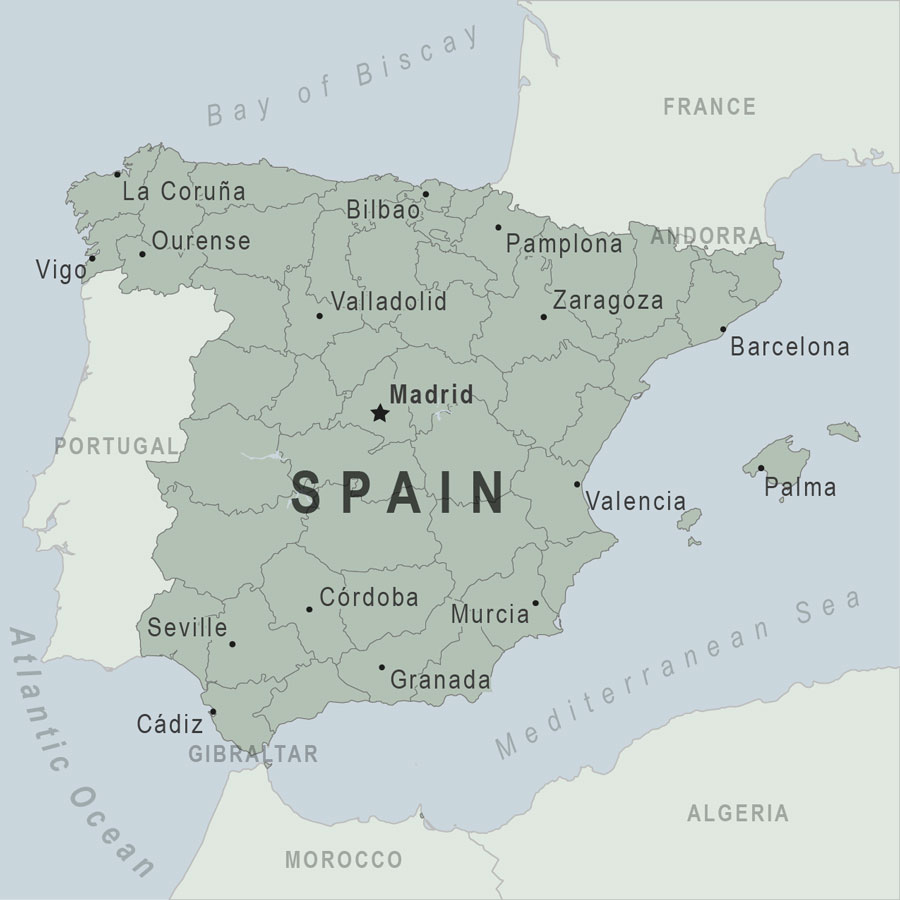
Five Quick Points About Spain
- Among top 15 study abroad destinations in world
- Fascinating southern European culture and society
- Spanish is a world language, and learning it gives access to Latin America
- Beautiful geographical contrasts – white beaches and snow-covered mountains
- Increasing emphasis on interdisciplinary studies
Location and Geography

Spain, with a total area of 504,750 square kilometres, occupies 85% of the Iberian Peninsula in the southwest of Europe, bordering the Mediterranean Sea and North Atlantic Ocean. The Pyrenees Mountains (north) border France and Andorra; Portugal lies to the west and (British) Gibraltar is a small peninsula in the South. The capital city is Madrid.
Mainland Spain is the second highest country in Europe and experiences three climatic types: continental (temperate clear, hot summers; cold winters), maritime (more moderate cloudy summers; cool partly cloudy winters along the coast) and Mediterranean (hot, dry summers; cool, wet winters). Droughts can be an issue for Spain.
Economy of Spain
Since joining the European Union (EU) in 1986, Spain has opened its economy to investment and trade, modernised its industrial base, improved infrastructure, and revised economic legislation to conform to EU guidelines. Main trading partners include France, Germany, Italy, and Great Britain. Spain’s principal exports are machinery, motor vehicles, wine, fruit and other food products, and pharmaceuticals; its tourism industry is among the largest in the world. The currency is the Euro.
Living Conditions and Cost of Living
The cost of living in Spain is generally lower than in many other European countries. It varies greatly by area, with the cost being much higher in the urban centres (e.g., Madrid, Valencia, and Barcelona) than in the rural Spanish villages and towns. Living costs for a student could range from €900–€1,300 per month for food, accommodation, and other general living expenses. Of course, living costs also vary depending on individual students’ lifestyle choices, the type of accommodation, and area in which they live.
Tuition fees vary considerably for EU and non-EU students, and range up to €3,500 for public universities and €20,000 for private institutions.
Education System
Spain has an essentially two-tier education system for schooling: compulsory (primary and secondary to 16 years) and post-compulsory (secondary and middle grade vocational). Tertiary and higher education consists of upper-grade vocational training and university.
Both public and private institutions provide higher education. Universities are divided into departamentos, facultades universitarias, escuelas tecnicas superiores, escuelas universitarias, institutos universitarios, and other centres, notably the colegios universitarios. The state-operated universities, private universities, and technical schools are entitled to grant professional university degrees. The Spanish university system offers degree and post-graduate programmes in all fields, including law, sciences, humanities, and medicine. The best Spanish technical schools offer programmes in engineering and architecture.
Information Specific to International Students
International students who are not from EU countries or from countries with bilateral agreements with Spain regarding university access (e.g., China) will need pass a series of aptitude tests – “Pruebas de Aptitud para el Acceso a la Universidad (PAU)” to be able to study at a Spanish university in Spain.
Students from the EU/EEA or Switzerland do not need a student visa to come to Spain, but international students from outside this area will need one to study, participate in a student exchange, get involved in research or training, or pursue an internship or volunteer position for more than three months. For visa information, please visit Study in Spain.
International students are permitted to work for to 20 hours a week while studying. The company that hires the student must obtain a work permit for the student according to the law.
